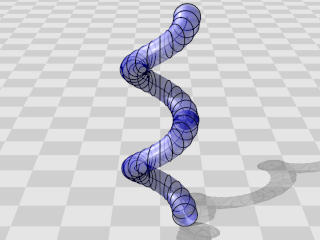Spring (mathematics)


In geometry, a spring is a surface in the shape of a coiled tube, generated by sweeping a circle about the path of a helix.[citation needed]
Definition
A spring wrapped around the z-axis can be defined parametrically by:
where
- is the distance from the center of the tube to the center of the helix,
- is the radius of the tube,
- is the speed of the movement along the z axis (in a right-handed Cartesian coordinate system, positive values create right-handed springs, whereas negative values create left-handed springs),
- is the number of rounds in circle.
The implicit function in Cartesian coordinates for a spring wrapped around the z-axis, with = 1 is
The interior volume of the spiral is given by
Other definitions
Note that the previous definition uses a vertical circular cross section. This is not entirely accurate as the tube becomes increasingly distorted as the Torsion[1] increases (ratio of the speed and the incline of the tube).
An alternative would be to have a circular cross section in the plane perpendicular to the helix curve. This would be closer to the shape of a physical spring. The mathematics would be much more complicated.
The torus can be viewed as a special case of the spring obtained when the helix degenerates to a circle.
References
- ^ "http://mathworld.wolfram.com/Helix.html".
{{cite web}}: External link in|title=












